As is often remarked, they don’t make ’em like they used to.
(Incidentally, I’m appreciating the increased time at home the past 7 months to catch up on my classic movie viewing.)
The Guns of Navarone from 1961 is an epic I missed the first time around. It has a tremendous following as the main actors attest to in the extras interviews. Gregory Peck, Anthony Quinn, and James Darren express surprise and delight that this is the film they are most often asked about 30-60 years later. And it is a special film with many admirable qualities and features.
This was a troubled English-American co-production on location in Rhodes in the Aegean except for London shooting with the director being replaced almost immediately by writer-producer Carl Foreman. J. Lee Thompson, a British director, was then brought on board, amazingly, shooting individual scenes after he read them, one at a time. (He would go on after this movie to direct Peck again in the powerful first version of Cape Fear in 1962.)
The production was filmed with the enthusiastic help of the Greek government, that gave the company permission to shoot at an unscaffolded Parthenon and supplied numerous extras as well as famed actress Irene Papas as one of two female characters adroitly added by Foreman to the script. A ballet company supplied extras for the wedding party scene and several Greek WW II destroyers were commandeered for the climax.
Foreman’s script derived from Alistair MacLean’s original novel which led to a string of movie successes for MacLean books in the ’60s. The writing is very strong fleshing out, with many moral and character conflicts, what was simply a modern adventure-action yarn about Allied commandos trying to take out a Nazi cannon fortress in WW II.
The stars were well-cast in this ensemble cast who had many of their scenes shot as group episodes so the viewer can see the reactions to various character choices and decisions.
Gregory Peck had previously played conflicted war heroes and his leader role was his best, culminating role of that series of war parts. He remains tough and unflinching even though he is challenged by the rest of the commandos.
Anthony Quinn steals the show. As the director points out, Quinn was so versatile, he played scenes hundreds of different of ways successfully. His role is as the likable right-hand man of Peck, who initially plans to kill Peck after the war for being responsible for the deaths of his family earlier in the war. He has the film’s most difficult acting scene, ‘losing it’ in the midst of Nazi captors.
David Niven had played many strong starring roles before (Stairway to Heaven, Separate Tables), but this is his best and most complex role as the explosives expert who remains loyal to his injured British leader-friend. He is the conscience of the fighters: a tricky part.
The supporting cast is equally strong and features British stalwarts: Stanley Baker, Anthony Quayle, James Robertson Justice, and Richard Harris, as well as young James Darren as the group’s designated psychotic killer.
The scenes are equally strong, memorable, and satisfying: as the mission gets going, the fight on open water when Nazis board the commandos’ boat, the stormy crash landing at Navarone (shot in a water tank in which the stars might have been seriously injured as one extra attests to), the difficult mountain climb, the various skirmishes with the Nazis on the way to the gun nest, their capture and escape, the final attack on the guns, and the closing escape scenes and finale.
Special effects, for the time, are still fairly convincing for the most part; the film was nominated for and won an AA for these. The look of the film in this newly restored version is fantastic: a colorful, nicely delineated widescreen; amazing given some of the original sources had ‘vinegar-ed’.
The music is outstanding: a score by the legendary Dimitri Tiomkin. (Fortunately for aficionados, the hour-long score is available today on CD.)
The movie is a veritable war classic and ushered in a subsequent series of commando-style movies through the sixties and seventies; it is the granddaddy of them all. The movie was nominated for seven Oscars including Best Picture and won for its Special Effects.
A serious viewer of this special DVD reissue is lucky to have an extra disc of special features including 3 longer documentaries and several featurettes. All aspects of the film are highlighted including the shooting, the director, the composer, and the restoration itself. This version of the movie with the extra disc is the one to view.


